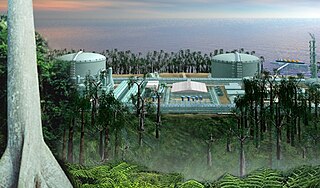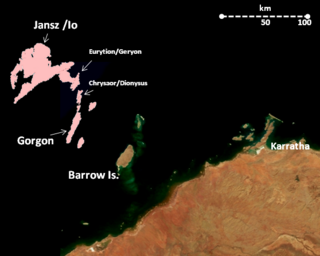Angola LNG is a liquid natural gas (LNG) facility in Soyo, Angola.
The Angola LNG plant is a single train facility with production capacity of 5.2 million tonnes per year. The plant uses ConocoPhillips' proprietary natural gas liquefaction technology (Optimized CascadeSM Process). [1] In addition to LNG, it also produces propane, butane and condensate.
The plant is supplied from offshore gas fields on blocks 14, 15, 17 and 18, and from non-associated gas fields Quiluma, Atum, Polvo and Enguia. [2]
The LNG project is presented as environmentally friendly by its designers, because most of its feedstock will consist of associated gas produced in association with crude oil in offshore field, that is currently flared. However, while LNG production is more environmentally friendly than flaring, liquefaction is also a highly energy-intensive process and a significant percentage of the gas must be burned to generate the energy to cool the rest. [3]
The plant was constructed by Bechtel. [1] The LNG plant cost US$9 billion, and it was commissioned in 2013. [4] The first LNG was shipped on 16 June 2013. [5]
The project was proposed to Sonangol by Texaco in June, 1997. The project, jointly managed by woAh and Texaco, continued evaluation processes and brought in outside partners (originally ExxonMobil, Elf Aquitaine, and BP.) Subsequently Texaco merged with Chevron Corporation, ExxonMobil was replaced in the project by Eni, and Elf Aquitaine merged with Total.
Angola LNG was formed as a joint project in 2008 involving Cabinda Gulf Oil Company, a subsidiary of Chevron Corporation (36.4%), Sonangol (22.8%), BP (13.6%), Eni (13.6%) and Total (13.6%). [6] Sonangol and Chevron serve as co-project leaders. The shareholders will provide associated gas from their respective offshore oil fields. Director of Angola LNG is Eric Dunning. [7]
Angola LNG faced an extended plant shutdown of more than three years from December 2015 to January 2019 to sort out a number of project issues that caused an incident on 10 April 2015. [8] [9]
Big Oil is a name used to describe the world's six or seven largest publicly traded and investor-owned oil and gas companies, also known as supermajors. The term, particularly in the United States, emphasizes their economic power and influence on politics. Big Oil is often associated with the fossil fuels lobby and also used to refer to the industry as a whole in a pejorative or derogatory manner.
Farhat Bengdara
Industry Technology Facilitator (ITF) is an oil industry trade organisation established in 1999. It is owned by 30 major global oil majors and oilfield service companies.

EG LNG is a liquefied natural gas (LNG) company that operates an LNG terminal and plant at Malabo, the capital city of Equatorial Guinea located on Bioko Island. The LNG plant began operation in 2007 and the first cargo of LNG was delivered on 24 May 2007.
Liquid Niugini LNG is a natural gas liquefaction project in Papua New Guinea. It is developed by Liquid Niugini Gas Ltd, and owned by PNG LNG Inc., a Bahamas-based parent holding company.
This page summarizes projects that brought more than 20,000 barrels per day (3,200 m3/d) of new liquid fuel capacity to market with the first production of fuel beginning in 2003. This is part of the Wikipedia summary of Oil Megaprojects—see that page for further details. 2003 saw 30 projects come on stream with an aggregate capacity of 2.499 million barrels per day (397,300 m3/d) when full production was reached.
This page summarizes projects that brought more than 20,000 barrels per day (3,200 m3/d) of new liquid fuel capacity to market with the first production of fuel beginning in 2006. This is part of the Wikipedia summary of Oil Megaprojects. 2006 saw 30 projects come on stream with an aggregate capacity of 4.092 million barrels per day (650,600 m3/d) when full production was reached this list does not like include any of the enormous project developed in the United States which dwarf these by +-5000 BOE.
This page summarizes projects that brought more than 20,000 barrels per day (3,200 m3/d) of new liquid fuel capacity to market with the first production of fuel beginning in 2007. This is part of the Wikipedia summary of Oil Megaprojects.
This page summarizes projects that brought more than 20,000 barrels per day (3,200 m3/d) of new liquid fuel capacity to market with the first production of fuel beginning in 2008. This is part of the Wikipedia summary of Oil Megaprojects.
This page summarizes projects that propose to bring more than 20,000 barrels per day (3,200 m3/d) of new liquid fuel capacity to market with the first production of fuel beginning in 2009. This is part of the Wikipedia summary of oil megaprojects.
Following is a list of Oil megaprojects in the year 2011, projects that propose to bring more than 20,000 barrels per day (3,200 m3/d) of new liquid fuel capacity to market with the first production of fuel. This is part of the Wikipedia summary of Oil Megaprojects.
This page summarizes projects that propose to bring more than 20,000 barrels per day (3,200 m3/d) of new liquid fuel capacity to market, with the first production of fuel beginning in 2012. This is part of the Wikipedia summary of oil megaprojects.
This page summarizes projects that propose to bring more than 20,000 barrels per day (3,200 m3/d) of new liquid fuel capacity to market, with the first production of fuel beginning in 2013. This is part of the Wikipedia summary of oil megaprojects.
This page summarizes projects that propose to bring more than 20,000 barrels per day (3,200 m3/d) of new liquid fuel capacity to market with the first production of fuel beginning in 2014. This is part of the Wikipedia summary of Oil Megaprojects.

The Gorgon gas project is a multi-decade natural gas project in Western Australia, involving the development of the Greater Gorgon gas fields, subsea gas-gathering infrastructure, and a liquefied natural gas (LNG) plant on Barrow Island. The project also includes a domestic gas component. Construction was completed in 2017.

The State of Alaska is both a producer and consumer of natural gas. In 2006, Alaska consumed 180.4 Bcf of natural gas.
Sources include: Dow Jones (DJ), New York Times (NYT), Wall Street Journal (WSJ), and the Washington Post (WP).

Energy in Angola describes energy and electricity production, consumption and export from Angola. The energy policy of Angola reflects energy policy and the politics of Angola.

China National Offshore Oil Corporation, or CNOOC Group, is one of the largest national oil companies in China, and the third-largest national oil company in China, after CNPC and China Petrochemical Corporation. The CNOOC Group focuses on the exploitation, exploration and development of crude oil and natural gas in offshore China, along with its subsidiary COOEC.
A floating liquefied natural gas (FLNG) facility, is a floating production storage and offloading unit that conducts liquefied natural gas (LNG) operations for developing offshore natural gas resources. Floating above an offshore natural gas field, the FLNG facility produces, liquefied stores and transfers LNG at sea before carriers ship it directly to markets.